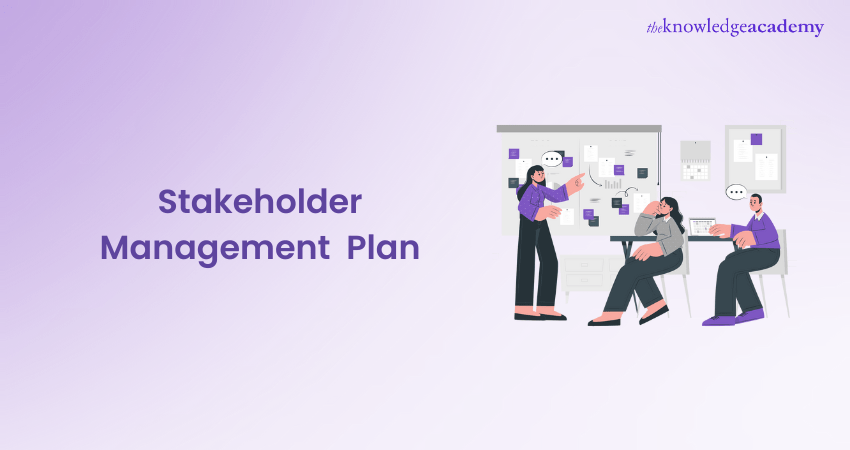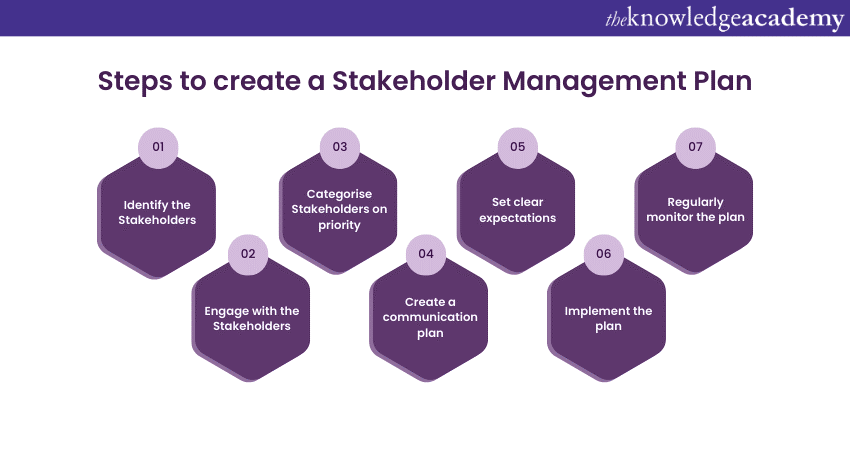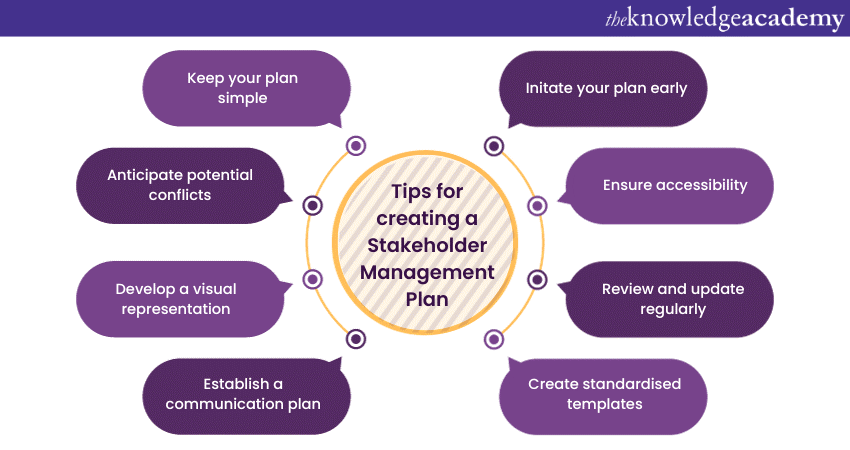We may not have the course you’re looking for. If you enquire or give us a call on +918037244591 and speak to our training experts, we may still be able to help with your training requirements.
We ensure quality, budget-alignment, and timely delivery by our expert instructors.

Let’s say that you are leading a big project, everything seems to be going smoothly, and then suddenly, a key Stakeholder raises concerns that throw everything off track. Does it sound frustrating? This is exactly why a Stakeholder Management Plan is essential. It helps you map out who’s involved, what they need, and how to keep them aligned from start to finish.
Without a proper Stakeholder Management Plan, miscommunication and roadblocks are almost inevitable. But with the right strategy, you can build trust and drive your project forward. Ready to take control and manage your stakeholders like a pro? Dive in!
Table of Contents
1) What is Stakeholder Management?
2) Importance of Stakeholder Management Plan
3) Who Creates a Stakeholder Management Plan?
4) What is Covered in a Stakeholder Management Plan?
5) Steps to Create a Stakeholder Management Plan
6) Top Tips for Creating an Effective Stakeholder Management Plan
7) Consequences of Neglecting a Stakeholder Management Plan
8) Sample Stakeholder Management Plan Template
9) Conclusion
What is a Stakeholder Management Plan?
A Stakeholder Management Plan is a strategic document used in Project Management. It help to identify, prioritise, and manage interactions with all individuals or groups who have a vested interest in the outcome of a project. This plan aims to ensure that stakeholders are appropriately engaged and their expectations are effectively managed throughout the project lifecycle.
Importance of Stakeholder Management Plan
A Stakeholder Management Plan is not just a document. It is the compass that guides a project towards its successful completion. Understanding its significance is important for Project Managers and teams as it serves as a linchpin in project success. Let’s explore the importance of this well-thought-out plan:
1) Enhanced Communication: A Stakeholder Management Plan outlines how, when, and what to communicate to each Stakeholder group. This ensures that all relevant information reaches the right people at the right time, minimising misunderstandings and conflicts.
2) Risk Mitigation: Identifying potential sources of resistance, opposition, or obstacles among Stakeholders early in the project is essential. A well-crafted Plan allows Project Managers to proactively address concerns, reducing the risk of project delays and budget overruns.
3) Stakeholder Support: Engaging with Stakeholders and seeking their input fosters a sense of ownership and buy-in. This support is important for project success, as it encourages Stakeholders to actively contribute to the project's goals.
4) Alignment with Objectives: The Stakeholder Management Plan ensures that the project's objectives align with the interests and expectations of all Stakeholders, from clients to team members. This alignment helps avoid conflicts and keeps everyone on the same page.
5) Resource Allocation: A good Plan helps in the efficient allocation of resources, ensuring that the right amount of time and effort is dedicated to managing Stakeholder relationships. This, in turn, streamlines project execution.
6) Continuous Improvement: The Plan is not static; it evolves throughout the project. Regularly monitoring Stakeholder satisfaction and engagement levels allows for adjustments and improvements, aligning with Stakeholder Capitalism for project success.
7) Conflict Resolution: A Stakeholder Management Plan includes procedures for addressing conflicts and disputes. When issues arise, the plan provides a structured approach to resolution, maintaining project harmony.
8) Client Satisfaction: In client-centric projects an effective Stakeholder Management Plan helps keep clients informed and engaged, resulting in higher levels of satisfaction and potential for future collaborations.
In summary, a Stakeholder Management Plan is the strategic nucleus of Project Management. It ensures that all Stakeholders are effectively engaged, informed, and satisfied, minimising risks and enhancing the project's chances of success. By recognising its importance and adhering to its principles, Project Managers and teams can navigate the complexities of Stakeholder dynamics with confidence and competence.
Turn complex processes into clear, efficient workflows—master Business Process Mapping Training now!
Who Creates a Stakeholder Management Plan?
Creating a Stakeholder Management Plan is a collaborative effort typically led by the Project Manager, but it involves various team members and stakeholders themselves. This multifaceted approach ensures a well-rounded and effective plan that addresses the diverse needs and expectations of all involved parties. Here's the list of people involved in creating a Project Management Plan: If you're preparing for a job interview, reviewing Stakeholder Management Interview Questions can help you understand how to navigate this process and highlight your ability to engage with different stakeholders effectively during your interview.

1) Project Manager: When it comes to creating the Stakeholder Management Plan, the Project Manager plays a central role. They are responsible for overseeing the project and its successful completion. They lead the process, from identifying Stakeholders to setting engagement strategies and monitoring progress. Creating this plan is one of the most important Roles and Responsibilities of a Project Manager.
2) Project Team Members: Team members are instrumental in the development of the plan. Their insights into the project's technical aspects, challenges, and interactions with Stakeholders are invaluable. They provide a realistic view of Stakeholder dynamics.
3) Stakeholders: Involving Stakeholders in the planning process is crucial. They can offer essential input, helping to refine the plan. Their perspectives on engagement, expectations, and communication preferences are invaluable.
4) Subject Matter Experts (SMEs): Depending on the project's nature, SMEs may be consulted. Their knowledge and expertise contribute to a more comprehensive and informed Stakeholder Management Plan.
5) Sponsors: Sponsors and decision-makers have a vested interest in the project's success. Their support and commitment to the plan are vital for its execution.
The collaborative approach to Stakeholder Management Plan creation promotes a well-rounded, inclusive, and effective strategy. It fosters a sense of ownership among team members and Stakeholders, which is essential for the plan's success. By engaging all relevant parties, the plan becomes a dynamic tool that can adapt to evolving project needs and Stakeholder expectations.
What is Covered in a Stakeholder Management Plan?
A Stakeholder Management Plan has basically four key parts:
a) Prioritising Stakeholders: Rank them based on their influence and interest in the project.
b) Understanding Expectations: Know what they expect, how they like to communicate, and what they want to be involved in.
c) Communication Rules: Set how often, how, and who will communicate with them.
d) Action Plan: Outline steps to manage their involvement and meet expectations.
Steps to Create a Stakeholder Management Plan
Creating a Stakeholder Management Plan is a systematic process that involves several essential steps. Each step adds to the overall effectiveness of the plan. Here's a breakdown of the key steps to create a Stakeholder Management Plan:

Step 1: Create a List of Stakeholders
The first step is to identify and list all potential Stakeholders associated with the project. Stakeholders can include Project Sponsors, team members, clients, suppliers, regulatory bodies, and anyone else who may be affected by or have an interest in the project. Comprehensive Stakeholder identification is crucial to ensure that no one is overlooked.
Step 2: Meet With Each Stakeholder
Once Stakeholders are identified, the next step is to engage with them individually or in groups. Meetings and discussions with Stakeholders are essential to understand their interests, concerns, and expectations regarding the project. These interactions provide valuable insights that inform the plan's development.
Clarify stakeholder roles and responsibilities with our easy-to-follow guide. Get started now!
Step 3: Prioritise All Stakeholders
In general, not all Stakeholders are equal in terms of influence and effect on the project. It's important to categorise Stakeholders based on their level of involvement and significance. Prioritising stakeholders helps optimise engagement and communication strategies to tackle the needs of each group effectively.
Step 4: Create a Communication Plan
A well-defined communications plan is a key component of the Stakeholder Management Plan. It outlines how, when, and what information will be communicated to Stakeholders. It includes the selection of communication channels, messaging, responsible parties, and the frequency of communication to keep Stakeholders informed and engaged.
Step 5: Establish Expectations
Setting clear expectations for Stakeholder engagement and support is vital. They should clearly understand the Roles and Responsibilities of a Stakeholder and the project's objectives. Establishing mutual expectations confirms that everyone involved is on the same page and reduces the likelihood of conflicts.
Master standard deviation calculations and their significance! Learn with real-life examples today.
Step 6: Implement the Plan into Action
With the plan in place, it's time to put it into action. This involves executing the defined strategies for Stakeholder engagement, communication, and management. Project Managers and teams must ensure that the plan is actively followed throughout the project's lifecycle.
Step 7: Monitor its Progress and Success
Regularly monitoring the Stakeholder Management Plan's progress is essential. This involves assessing Stakeholder satisfaction, engagement levels, and the effectiveness of communication and engagement strategies. Monitoring allows for adjustments and improvements as necessary to maintain Stakeholder support.
By following these top tips, you can create a Stakeholder Management Plan that is adaptable and efficient and fosters positive Stakeholder relationships. This, in turn, contributes to project success and client satisfaction.
Enhance your Business Analysis knowledge with our Certified Business Analyst Professional (CBA-PRO) Training – sign up today!
Top Tips for Creating an Effective Stakeholder Management Plan
Creating an effective Stakeholder Management Plan is pivotal for project success. Here are some top tips to guide you in crafting a robust plan:

1) Clarity and Simplicity: Keep your plan clear and straightforward, focusing on essential project aspects. Use plain language and high-level details to ensure broad comprehension.
2) Proactive Conflict Resolution: Anticipate potential conflicts and incorporate conflict resolution strategies into your plan. This ensures that Stakeholders are aware of the process for addressing disputes.
3) Stakeholder Prioritisation: Develop a visual representation that ranks Stakeholders based on their interests and influence. This simplifies the identification of key areas where your efforts should be concentrated for project success.
4) Transparent Communication: Establish a communication plan that fosters transparency. Encourage open, two-way communication to build trust and secure Stakeholder support.
5) Early Planning: Initiate your Stakeholder Management Plan early in the project. Identifying and engaging with key Stakeholders at the outset can boost their involvement and commitment.
6) Accessibility: Ensure all Stakeholders have access to the plan. Making it accessible promotes transparency, preventing the omission of important information or Stakeholders during development.
7) Regular Updates: Review and update your plan consistently throughout the project. Stakeholder dynamics may change, leading to different expectations or engagement levels.
8) Standardised Templates: Create standardised templates for your Stakeholder Management Plans. This promotes consistency, minimises the risk of overlooking critical details, and expedites plan development.
By following these top tips, you can create a Stakeholder Management Plan that is adaptable, efficient and fosters positive Stakeholder relationships. This, in turn, contributes to project success and client satisfaction.
Start making faster moves – register for our Introduction to Business Analytics Training and turn data into decisions!
Consequences of Neglecting a Stakeholder Management Plan
Neglecting a Stakeholder Management Plan can have significant repercussions for your project. Here are five major consequences of neglecting it:
1) Misaligned Objectives: Failing to manage Stakeholders can lead to conflicts and hinder progress. This happens due to a misalignment between project goals and Stakeholder interests.
2) Loss of Support: Ignored Stakeholders may withdraw their support, making it difficult to achieve project objectives and introducing additional challenges.
3) Increased Risks: Unmanaged Stakeholders can introduce unforeseen risks, including disputes, resistance, delays, and, in some cases, project failure.
4) Resource Wastage: Inefficient resource allocation due to a lack of planning can impact project budgets and timelines, potentially leading to wastage.
5) Reputation Damage: Inadequate Stakeholder Management can tarnish your organisation's reputation, negatively affecting its standing and future endeavours.
In summary, neglecting a Stakeholder Management Plan can result in various adverse consequences. These consequences include impeding project success, increasing risks, and damaging relationships. Recognising the vital role of Stakeholder Management and dedicating the necessary time and resources to create an effective plan is crucial.
Sample Stakeholder Management Plan Template
Creating a Stakeholder Management Plan can feel overwhelming, but a simple template can help. Here’s an example of a new email marketing campaign with different team members involved.

Using a collaborative platform like Wrike or Asana can help track tasks and ensure everyone stays aligned on the project!
Conclusion
To conclude, a Stakeholder Management Plan isn’t just about processes; it’s about people. Strong relationships can make or break a project, and the way you engage with stakeholders shapes your success. Keep them informed, listen to their needs, and turn collaboration into a competitive advantage.
Transform your Business Analysis skills with our Business Analyst Fundamentals Training – Sign up today!
Frequently Asked Questions
What are The Four Major Components of the Stakeholder Management Plan?

The four major components of the Stakeholder Management Plan are stakeholder identification, stakeholder analysis, stakeholder engagement strategy, and management approach. Identification involves pinpointing all relevant parties, while analysis assesses their interest and influence.
What are the Seven Cs of Stakeholder Management?

The Seven Cs of Stakeholder Management are Communication, Consultation, Collaboration, Compromise, Consensus, Commitment, and Continuity.
What are the Other Resources and Offers Provided by The Knowledge Academy?

The Knowledge Academy takes global learning to new heights, offering over 3,000 online courses across 490+ locations in 190+ countries. This expansive reach ensures accessibility and convenience for learners worldwide.
Alongside our diverse Online Course Catalogue, encompassing 19 major categories, we go the extra mile by providing a plethora of free educational Online Resources like News updates, Blogs, videos, webinars, and interview questions. Tailoring learning experiences further, professionals can maximise value with customisable Course Bundles of TKA.
What is The Knowledge Pass, and How Does it Work?

The Knowledge Academy’s Knowledge Pass, a prepaid voucher, adds another layer of flexibility, allowing course bookings over a 12-month period. Join us on a journey where education knows no bounds.
What are the Related Courses and Blogs Provided by The Knowledge Academy?

The Knowledge Academy offers various Business Analysis Courses, including the BCS Practitioner Certificate in Requirements Engineering Course, and the CS Foundation Certificate in Organisational Behaviour Course. These courses cater to different skill levels, providing comprehensive insights into Business Analysis Services.
Our Business Analysis Blogs cover a range of topics related to Stakeholder Management, offering valuable resources, best practices, and industry insights. Whether you are a beginner or looking to advance your Business Analysis skills, The Knowledge Academy's diverse courses and informative blogs have got you covered.
Upcoming Business Analysis Resources Batches & Dates
Date
 Creating Effective Stakeholder Engagement Training
Creating Effective Stakeholder Engagement Training
Fri 2nd May 2025
Fri 5th Sep 2025
Fri 5th Dec 2025






 Top Rated Course
Top Rated Course



 If you wish to make any changes to your course, please
If you wish to make any changes to your course, please


